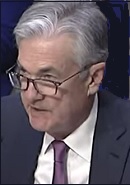By Pam Martens and Russ Martens: February 11, 2020 ~
At 10:00 a.m. this morning, the Chairman of the Federal Reserve, Jerome (Jay) Powell, will take his seat in the Rayburn House Office Building to deliver his semiannual testimony to the House Financial Services Committee and answer a multitude of questions on what the Fed has been up to lately. Powell will repeat the process again tomorrow before the Senate Banking Committee.
The public already knows the kinds of questions Democrats are going to lob at Powell tomorrow because Senators Sherrod Brown, Elizabeth Warren, Jack Reed and Tina Smith sent a letter to Powell on February 6, listing the specific questions they want answers to in preparation for the hearing on February 12. The questions are exclusively focused on the Fed’s unprecedented repo loans to Wall Street’s trading houses that began on September 17 of last year and have been made every single business day since that time. The cumulative tally of the loans is now more than $6.6 trillion, more than a third of the Fed loans made during the financial crisis. And yet, Powell insists there is no crisis on Wall Street. The Senators demanded answers to the following questions:
“1) Has the Fed determined the cause for the protracted, increased demand for reserves that necessitates continued intervention through repo activities? If so, what is/are the cause or causes?
“2) Has the Fed analyzed the impact of the availability of this facility on primary dealers’ balance sheets and market activity? If so, what has changed in money markets since September 2019? Are other portfolios affected by these adjustments and reallocations?
“3) Could a bank use access to this facility to game capital or liquidity standards, and what steps are supervisors taking to ensure that is not the case?
“4) Have profits at banks that have access to this facility outpaced profits at similarly situated financial institutions that do not have access or have not participated in the facility? If so, does that suggest anything about the efficiency of overnight repo operations as a transmission mechanism for monetary policy?
“5) The facility has reduced the cost of access to cash in the money markets – to what degree has the cost of borrowing been reduced to consumers, specifically those with outstanding loans? In your estimation, do banks or consumers primarily benefit from the operation of this facility?
“6) Since September 2019, has the Board discussed the possibility of weakening or otherwise altering liquidity, capital, or other regulatory and supervisory standards in order to address this issue? Does the Board continue to consider any such changes? Has the Board or FRBNY considered the possibility that market actors refused to lend into the market, sacrificing short-term profits in order to raise questions about prudential regulation? Would it be feasible for the small network of primary dealers to do so?”
As for question 5, we can assure the Senators that Wall Street behemoths like Citigroup and JPMorgan Chase, whose trading units have access to the Fed’s repo loans, have not significantly reduced their credit card interest rates to consumers. Both banks are charging credit card rates in the high double digits while they have had access to Fed repo loans for months at an interest rate of 1.55 percent, now gently increased to 1.60 percent.
When the Senators ask in question 6 as to whether it would be “feasible for the small network of primary dealers” to collude to get the Fed to loosen its regulatory requirements on their Wall Street behemoth parents, this is clearly a rhetorical question. These Senators know very well that these are the same Wall Street trading outfits that have been colluding for the past three decades – on everything from price fixing on Nasdaq, to rigging the Libor benchmark interest rate and foreign exchange markets. These Wall Street trading houses are so brazen that even their General Counsels meet together secretly – in complete defiance of antitrust law. (See Yes, America, a Banking Cartel Exists and Here’s the Proof.)
As for today’s hearing at the House Financial Services Committee, a copious Memorandum has been released by the Committee outlining legislation since 1977 that shows Congress has given “explicit policy instructions” to the Fed to govern its behavior. Its mandate, put simply, is to pursue “…the goals of maximum employment, stable prices, and moderate long-term interest rates.” There is nothing in the legislation about the Fed being able to operate a limitless money feeding tube to Wall Street every time its bad bets go awry.


